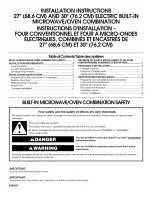
4
Electrical Requirements
If codes permit and a separate ground wire is used, it is
recommended that a qualified electrical installer determine that
the ground path and the wire gauge are in accordance with local
codes.
Check with a qualified electrical installer if you are not sure the
oven is properly grounded.
This oven must be connected to a grounded metal, permanent
wiring system.
Be sure that the electrical connection and wire size are adequate
and in conformance with the National Electrical Code, ANSI/NFPA
70-latest edition or CSA Standards C22.1-94, Canadian Electrical
Code, Part 1 and C22.2 No. O-M91-latest edition, and all local
codes and ordinances.
A copy of the above code standards can be obtained from:
National Fire Protection Association
One Batterymarch Park
Quincy, MA 02269
CSA International
8501 East Pleasant Valley Road
Cleveland, OH 44131-5575
Electrical Connection
To properly install your oven, you must determine the type of
electrical connection you will be using and follow the instructions
provided for it here.
■
Oven must be connected to the proper electrical voltage and
frequency as specified on the model/serial number rating
plate. The model/serial number rating plate is located near
center vent of the lower oven. See the following illustration.
■
Models rated from 7.3 to 9 kW at 240 volts (5.4 to 7.4 kW at
208 volts) require a separate 40-amp circuit. Models rated at
4.8 kW and below at 240 volts (3.6 kW and below at 208 volts)
require a separate 20-amp circuit.
■
A circuit breaker is recommended.
■
Connect directly to the fused disconnect (or circuit breaker
box) through flexible, armored or nonmetallic sheathed,
copper cable (with grounding wire). See “Make Electrical
Connection” section.
■
Flexible conduit from the oven should be connected directly to
the junction box.
■
Do not cut the conduit. The length of conduit provided is for
serviceability of the oven.
■
A UL listed or CSA approved conduit connector must be
provided.
■
If the house has aluminum wiring follow the procedure below:
1. Connect a section of solid copper wire to the pigtail
leads.
2. Connect the aluminum wiring to the added section of
copper wire using special connectors and/or tools
designed and UL listed for joining copper to aluminum.
Follow the electrical connector manufacturer's recommended
procedure. Aluminum/copper connection must conform with
local codes and industry accepted wiring practices.
A. Model/serial number plate (located on
underside of center vent)
A


































